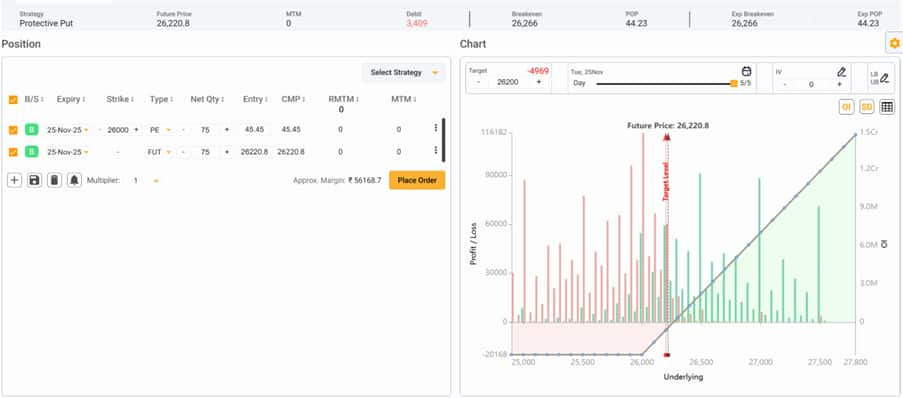Six rules to follow if you are an Options trader with small capital
Options trading is complex endeavour, unlike cash market investing, a startup guide indicating certain pointers, which are presented ahead. The six rules should help option traders.
SHUBHAM AGARWAL | 24-Apr-21
Reading Time: 3 minutes

Nifty has surged about 100% from the swing low of 2020. The Indian market in the last year has also witnessed a huge number of additions in trading accounts due to more time available with people working from home to allocate to trading. Most of these traders are newbies and often come with small capital to be deployed.
Any options trade of less than Rs 2,00,000 is termed as small capital. And since small capital can deploy low capital strategies, we will consider only buying options which could be both calls and puts.
Options trading , unlike futures or cash market trading, has a lot of complexities and hence I’ll list down few quick fixes to know for a guided start.
Position Sizing
Let us start with how much capital you should deploy. Generally, newbies make the mistake of treating options like stocks. Options are wasting assets and have a very small shelf life mostly a month for Indian markets as expiries beyond that aren’t liquid.
This means that deploying full capital would mean blowing up complete capital in just a few months and sadly this is the fact where within 6 months most of the traders blow up their accounts. So, it is important to know how much capital to deploy in each trade.
To understand the concept of why we need position sizing, consider this example. Let’s say we are flipping coins to predict the outcome of head or tail, we know with enough number of iterations eventually it will be 50:50, but what if you predict Tails and Head pops-up 5 consecutive times? Will you have enough capital to sustain that bet? This is exactly where position sizing helps.
For small accounts, I recommend a per trade allocation of 5% with an overall allocation of 10% at any given point in time. That means with a capital of Rs 2,00,000 one should allocate no more than Rs 10,000 for each trade and two parallel trades can be opened at a time. This will help you sustain consecutive losses.
Setting the Holding Period
Trading single options should have a defined maximum holding period. A common mistake new entrants make is holding the trade for too long which deteriorates the probability of making money due to theta decay outrunning the probability of profit. Single Option trades should be extremely short term so participating in breakout/breakdown zones and quickly moving out of the trade should be the intention.
If you want to carry trades, then the maximum holding period should be 3 days but in expiry week this should come down to intraday. So, one needs to follow the time stop loss and exit without relying on hope.
Pre-calculate Stops & Targets
Forecasting studies are generally conducted using the underlying instruments and it's extremely important to align your option trades to those targets and stops.
Using an Options Calculator which is generally available online, can help to convert your underlying stops and targets to option stops and targets. Pre-calculate the option level using underlying forecast levels and time. This will help your trades avoid whipsaws due to inaccurate calculations.
Avoid stocks in news
Often newb investors jump in heard trading i.e. stocks that are hot in news. Generally, as the market has a unique way of predicting the impact of news, what might sound positive news may have been accounted for in the price or the market may have a different prediction methodology trapping the price in a reverse direction. Stock valuations don’t matter much to options trading as the time scale for these trades are extremely short term and things are more led by demand and supply in short term.
Avoid unknown events
Another general mistake is to trade events where outcomes are unknown, which is very close to gambling. Remember most people lose in a casino as they enter with an intention to gamble and have fun.
If you treat your trading like a business, you will never want to enter a trade that leads to a gamble. So, avoiding event days like Monetary policies, upcoming stock results, fiscal policies, etc. is generally a good idea. In these events, even if your predictions are right still you may lose to volatility.
Limit number of open trades
Managing multiple trades simultaneously is a difficult task, so before adding a trade always ask yourself is there an open trade that can be replaced? If yes, choose to replace than to increase the overall bet. I recommend not to hold more than 2-3 open trades at any given time.
Learn and read more about nse open interest data from Quantsapp classroom which has been curated for understanding of open interest from scratch, to enable option traders grasp the concepts practically and apply them in a data-driven trading approach.
Recent Articles

How to make profit when markets go sideways: Shubham Agarwal
20-Dec-25

Beyond Panic: Take control when your derivatives trade turns red, says Shubham Agarwal!
13-Dec-25

Evolve Your Trade: The missing step in most trading systems: Shubham Agarwal
06-Dec-25

Best trending option trading strategies: Shubham Agarwal
29-Nov-25

3 best ways to hedge using Options: Shubham Agarwal!
22-Nov-25

When in doubt to write, do Iron Fly: Shubham Agarwal!
15-Nov-25

Identify potential turning points with advance-decline: Shubham Agarwal
08-Nov-25

Slow and spreads more efficient: Shubham Agarwal
01-Nov-25

SHUBHAM AGARWAL is a CEO & Head of Research at Quantsapp Pvt. Ltd. He has been into many major kinds of market research and has been a programmer himself in Tens of programming languages. Earlier to the current position, Shubham has served for Motilal Oswal as Head of Quantitative, Technical & Derivatives Research and as a Technical Analyst at JM Financial.
Recent Articles

How to make profit when markets go sideways: Shubham Agarwal
20-Dec-25 12:14:00

Beyond Panic: Take control when your derivatives trade turns red, says Shubham Agarwal!
13-Dec-25 09:12:00

Evolve Your Trade: The missing step in most trading systems: Shubham Agarwal
06-Dec-25 20:43:00

Best trending option trading strategies: Shubham Agarwal
29-Nov-25 09:32:00

3 best ways to hedge using Options: Shubham Agarwal!
22-Nov-25 09:11:00

When in doubt to write, do Iron Fly: Shubham Agarwal!
15-Nov-25 10:48:00

Identify potential turning points with advance-decline: Shubham Agarwal
08-Nov-25 10:35:00











